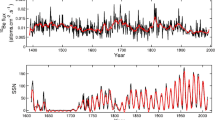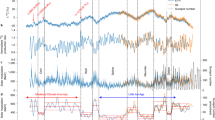Abstract
Beryllium-10 in ice provides a valuable proxy of solar activity. However, complex production pathways, atmospheric transport, and deposition processes impede its quantitative interpretation. Here, we examine the influence of deposition processes on two Be-10 ice core records from Central Antarctica (South Pole and Dome Fuji stations), covering the last millennium. We try to quantify how Be-10 variations in ice relate to variations in Be-10 production, and the bias associated to this relationship. An independent bias estimation is provided by comparing atmospheric radiocarbon variations reconstructed from tree rings and deduced from Be-10 variations. Both techniques suggest an uncertainty of the order of 10% in Be-10 production. This uncertainty estimate does not account for the geographical origin of Be-10, which remains a major issue. Because both Be-10 records are so similar, we propose to average them as a means to decrease the unshared (non solar) variability. This average record provides a new reconstruction of solar modulation parameter Φ and total solar irradiance over the last ~1,300 years. The lowest solar activity is found during the so-called Spörer Minimum (around AD 1450). The highest activities are found during the 8th century and over the last decades: as shown in previous studies, our results suggest that the recent solar activity is not exceptionally high for the last millennium.





Similar content being viewed by others
References
Bard E et al (1997) Solar modulation of cosmogenic nuclide production over the last millennium: comparison between 14C and 10Be records. Earth Planet Sci Lett. doi:10.1016/S0012-821X(97)00082-4
Bard E et al (2000) Solar irradiance during the last 1200 years based on cosmogenic nuclides. Tellus. doi:10.1034/j.1600-0889.2000.d01-7.x
Bard E et al (2007) Comment on “Solar activity during the last 1000 yr inferred from radionuclide records” by Muscheler et al. (2007). Quat Sci Rev. doi:10.1016/j.quascirev.2007.06.002
Beer J et al (1987) 10Be measurements on polar ice: comparison of Arctic and Antarctic records. Nucl Instrum Methods Phys Res B 29:203–206. doi:10.1016/0168-583X(87)90236-9
Beer J et al (1990) Use of 10Be in polar ice to trace the 11-year cycle of solar activity. Nature. doi:10.1038/347164a0
Beer J, Tobias S, Weiss N (1998) An active sun throughout the Maunder Minimum. Solar Phys. doi:10.1023/A:1005026001784
Berggren A-M et al (2009) A 600-year annual 10Be record from the NGRIP ice core, Greenland. Geophys Res Lett 36:L11801. doi:10.1029/2009GL038004
Bergin MH et al (1998) Relationship between continuous aerosol measurements and firn core chemistry over a 10-year period at the South Pole. Geophys Res Lett 25:1189–1192. doi:10.1029/98GL00854
Damon PE, Sternberg RE (1989) Global production and decay of radiocarbon. Radiocarbon 31:697–703
de Vries HL (1958) Variation in concentration of radiocarbon with time and location on earth. Proc Koninklijke Nederlandse Akademie van Wetenschappen B61:94–102
Delmas RJ (1992) Free tropospheric reservoir of natural sulfate. J Atmos Chem. doi:10.1007/BF00115238
Delmas RJ et al (1992) 1000 years of explosive volcanism recorded at the South Pole. Tellus. doi:10.1034/j.1600-0889.1992.00011.x
Ekaykin AA et al (2002) Spatial and temporal variability in isotope composition of recent snow in the vicinity of Vostok station, Antarctica: implications for ice-core record interpretation. Ann Glaciol 35:181–186. doi:10.3189/172756402781816726
Ekaykin AA et al (2004) The changes in isotope composition and accumulation of snow at Vostok station, East Antarctica, over the past 200 years. Ann Glaciol. doi:10.3189/172756404781814348
Field CV et al (2006) Modeling production and climate-related impacts on 10Be concentration in ice cores. J Geophys Res. doi:10.1029/2005JD006410
Field CV, Schmidt GA (2009) Model-based constraints on interpreting 20th century trends in ice core 10Be. J Geophys Res. doi:10.1029/2008JD011217
Fröhlich C (2009) Evidence of a long-term trend in total solar irradiance. Astron Astrophys. doi:10.1051/0004-6361/200912318
Gleeson LJ, Axford WI (1968) Solar modulation of galactic cosmic rays. Astrophys J 154:1011–1026
Goslar T (2001) Absolute production of radiocarbon and the long-term trend of atmospheric radiocarbon. Radiocarbon 43:743–749
Hansen J et al (2008) Target atmospheric CO2: where should humanity aim? Open Atmos Sci J 2:217–231. doi:10.2174/1874282300802010217
Harder S, Warren SG, Charlson RJ (2000) Sulfate in air and snow at the South Pole: implications for transport and deposition at sites with low snow accumulation. J Geophys Res. doi:10.1029/2000JD900351
Heikkilä U, Beer J, Feichter J (2008) Modeling cosmogenic radionuclides 10Be and 7Be during the Maunder Minimum using the ECHAM5-HAM General Circulation Model. Atmos Chem Phys 8:2797–2809
Heikkilä U, Beer J, Feichter J (2009) Meridional transport and deposition of atmospheric 10Be. Atmos Chem Phys 9:515–527
Horiuchi K et al (2007) Concentration of 10Be in an ice core from the Dome Fuji station, Eastern Antarctica: preliminary results from 1500 to 1810 yr AD. Nucl Instrum Methods Phys Res. doi:10.1016/j.nimb.2007.01.306
Horiuchi K et al (2008) Ice core record of 10Be over the past millennium from Dome Fuji, Antarctica: a new proxy record of past solar activity and a powerful tool for stratigraphic dating. Quatern Geochronol. doi:10.1016/j.quageo.2008.01.003
Houtermans JC (1966) On the quantitative relationships between geophysical parameters and the natural C14 inventory. Zeitschrift für Physik 193:1–12
Hughen K et al (2004) 14C activity and global carbon cycle changes over the past 50,000 years. Science 303:202–207
Huke M et al (2002) Air-firn-transfer of 10Be at European deep drilling sites in Antarctica. Paul Scherrer Institute Annual report, Villigen, Switzerland
Iizuka Y et al (2004) SO4 2− minimum in summer snow layer at Dome Fuji, Antarctica, and the probable mechanism. J Geophys Res 109:D04307. doi:10.1029/2003JD004138
IPCC (2007) Climate Change 2007 - The Physical Science Basis. Cambridge University Press, Cambridge, UK
Joussaume S, Taylor KE (1995) Status of the paleoclimate modeling intercomparison project (PMIP). In: Gates WL (ed) Proc First Int AMIP Sci Conf, Monterey, pp 425–430
Jouzel J et al (1983) Climatic information over the last century deduced from a detailed isotopic record in the South Pole snow. J Geophys Res. doi:10.1029/JC088iC04p02693
Kameda T et al (1997) Surface mass balance, sublimation and snow temperatures at Dome Fuji Station, Antarctica, in 1995. Proc 19th NIPR Symp Polar Meteorol Glaciol 11:24–34
Kameda T et al (2008) Temporal and spatial variability of surface mass balance at Dome Fuji, East Antarctica, by the stake method from 1995 to 2006. J Glaciol. doi:10.3189/002214308784409062
Kirchner S, Delmas RJ (1988) A 1000 year glaciochemical study at the South Pole. Ann Glaciol 10:80–84
Korte M, Donadini F, Constable CG (2009) Geomagnetic field for 0–3 ka: 2. A new series of time-varying global models. Geochem Geophys Geosyst. doi:10.1029/2008GC002297
Legrand M (1987) Chemistry of Antarctic snow and ice. J Physique 48(suppl):78–86
Legrand M (1995) Sulphur-derived species in polar ice: a review. In: Delmas RJ (ed) Ice core studies of global biogeochemical cycles. Springer, Berlin, pp 91–119
Lockwood M, Stamper R (1999) Long-term drift of the coronal source magnetic flux and the total solar irradiance. Geophys Res Lett. doi:10.1029/1999GL900485
Lockwood M (2002) An evaluation of the correlation between open solar flux and total solar irradiance. Astron Astrophys. doi:10.1051/0004-6361:20011666
Marchal O (2005) Optimal estimation of atmospheric 14C production over the Holocene: paleoclimate implications. Clim Dyn. doi:10.1007/s00382-004-0476-z
Masarik J, Beer J (1999) Simulation of particle fluxes and cosmogenic nuclide production in the Earth’s atmosphere. J Geophys Res 104:12099–12111
Masson V et al (2000) Holocene climate variability in Antarctica based on 11 ice-core isotopic records. Quatern Res. doi:10.1006/qres.2000.2172
McCracken KG (2004) Geomagnetic and atmospheric effects upon the cosmogenic 10Be observed in polar ice. J Geophys Res. doi:10.1029/2003JA010060
McCracken KG et al (2004) A phenomenological study of the long-term cosmic ray modulation, 850–1958 AD. J Geophys Res. doi:10.1029/2004JA010685
Mosley-Thompson E et al (1999) Late 20th Century increase in South Pole snow accumulation. J Geophys Res. doi:10.1029/1998JD200092
Mursula K, Usoskin IG, Kovaltsov GA (2003) Reconstructing the long-term cosmic ray intensity: Linear relations do not work. Ann Geophys 21:863–867
Muscheler R et al (2005) Climate: how unusual is today’s solar activity? Nature. doi:10.1038/nature04045
Muscheler R et al (2007) Solar activity during the last 1000 yr inferred from radionuclide records. Quat Sci Rev. doi:10.1016/j.quascirev.2006.07.012
Narita H et al (2003) Estimation of annual layer thickness from stratigraphical analysis of Dome Fuji deep ice core. Mem Natl Inst Polar Res 57(Special issue):38–45
Pedro J et al (2006) Evidence for climate modulation of the 10Be solar activity proxy. J Geophys Res. doi:10.1029/2005JD006764
Raisbeck GM et al (1981) Cosmogenic 10Be/7Be as a probe of atmospheric transport processes. Geophys Res Lett 8:1015–1018. doi:10.1029/GL008i009p01015
Raisbeck GM, Yiou F (1985) 10Be in polar ice and atmospheres. Ann Glaciol 7:138–140
Raisbeck GM et al (1990) 10Be and δ2H in polar ice cores as a probe of the solar variability’s influence on climate. Philos Trans Royal Soc London. doi:10.1098/rsta.1990.0027
Reimer PJ et al (2004) IntCal04 terrestrial radiocarbon age calibration, 0–26 Cal Kyr BP. Radiocarbon 46:1029–1058
Satow K et al (1999) The relationship among accumulation rate, stable isotope ratio and surface temperature on the plateau of East Dronning Maud Land, Antarctica. Polar Meteorol Glaciol 13:43–52
Shaw GE (1988) Antarctic aerosols: a review. Rev Geophys 26:89–112
Shindell DT et al (2003) Volcanic and solar forcing of climate change during the preindustrial era. J Climate. doi:10.1175/1520-0442(2003)016<4094:VASFOC>2.0.CO;2
Siegenthaler U, Beer J (1988) Model comparison of 14C and 10Be Isotope records. In: Stephenson FR, Wolfendale AW (eds) Secular solar and geomagnetic variations in the last 10,000 years. Kluwer, Durham, pp 315–328
Siegenthaler U, Heimann M, Oeschger H (1980) 14C variations caused by changes in the global carbon cycle. Radiocarbon 22:177–191
Smith AM et al (2000) 7Be and 10Be concentrations in recent firn and ice at Law Dome, Antarctica. Nucl Instrum Methods Phys Res B. doi:10.1016/S0168-583X(00)00281-0
Solanki SK et al (2004) Unusual activity of the Sun during recent decades compared to the previous 11,000 years. Nature. doi:10.1038/nature02995
Solanki SK et al (2005) Climate: how unusual is today’s solar activity? (reply). Nature. doi:10.1038/nature04046
Steig E, Stuiver M, Polissar P (1995) Cosmogenic isotope concentrations at Taylor Dome, Antarctica. Antarct. J. U. S. 30:95–97
Stocker TF, Wright DG (1996) Rapid changes in ocean circulation and atmospheric radiocarbon. Paleoceanography. doi:10.1029/96PA02640
Stuiver M (1961) Variations in radiocarbon concentration and sunspot activity. J Geophys Res 66:273–276
Stuiver M, Polach HA (1977) Discussion: reporting of 14C data. Radiocarbon 19:355–363
Stuiver M, Quay PD (1980) Changes in atmospheric carbon-14 attributed to a variable sun. Science 207:11–19
Stuiver M, Braziunas TF (1993) Sun, ocean, climate and atmospheric 14CO2: an evaluation of causal and spectral relationships. Holocene 3:289–305. doi:10.1177/095968369300300401
Usoskin IG et al (2002) A physical reconstruction of cosmic ray intensity since 1610. J Geophys Res. doi:10.1029/2002JA009343
Usoskin IG et al (2005) Heliospheric modulation of cosmic rays: monthly reconstruction for 1951–2004. J Geophys Res. doi:10.1029/2005JA011250
Usoskin IG et al (2006a) Solar proton events in cosmogenic isotope data. Geophys Res Lett. doi:10.1029/2006GL026059
Usoskin IG et al (2006b) Long-term solar activity reconstructions: direct test by cosmogenic 44Ti in meteorites. Astron Astrophys. doi:10.1051/0004-6361:20065803
Usoskin IG et al (2009) On the common solar signal in different cosmogenic isotope data sets. J Geophys Res. doi:10.1029/2008JA013888
van der Veen CJ et al (1999) Accumulation at South Pole: comparison of two 900-year records. J Geophys Res. doi:10.1029/99JD900501
Wagner G et al (2000) Reconstruction of the geomagnetic field between 20 and 60 kyr BP from cosmogenic radionuclides in the GRIP ice core. Nucl Instrum Methods Phys Res B. doi:10.1016/S0168-583X(00)00285-8
Wang Y-M, Lean J, Sheeley NRJ (2000) The long-term variation of the sun’s open magnetic flux. Geophys Res Lett. doi:10.1029/1999GL010744
Webber WR, Higbie PR (2003) Production of cosmogenic Be nuclei in the Earth’s atmosphere by cosmic rays: its dependence on solar modulation and the interstellar cosmic ray spectrum. J Geophys Res. doi:10.1029/2003JA009863
Webber WR, Higbie PR, McCracken KG (2007) Production of the cosmogenic isotopes 3H, 7Be, 10Be, and 36Cl in the earth’s atmosphere by solar and galactic cosmic rays. J Geophys Res. doi:10.1029/2007JA012499
Acknowledgments
We are indebted to Dr. Horiuchi for providing us the Dome Fuji 10Be data and for some comments, and to the reviewers for their constructive comments and careful language corrections. This study is a contribution to the VOLSOL project (ANR-09-BLAN-0003-01) funded by Agence Nationale de la Recherche (ANR).
Author information
Authors and Affiliations
Corresponding author
Electronic supplementary material
Below is the link to the electronic supplementary material.
Rights and permissions
About this article
Cite this article
Delaygue, G., Bard, E. An Antarctic view of Beryllium-10 and solar activity for the past millennium. Clim Dyn 36, 2201–2218 (2011). https://doi.org/10.1007/s00382-010-0795-1
Received:
Accepted:
Published:
Issue Date:
DOI: https://doi.org/10.1007/s00382-010-0795-1




